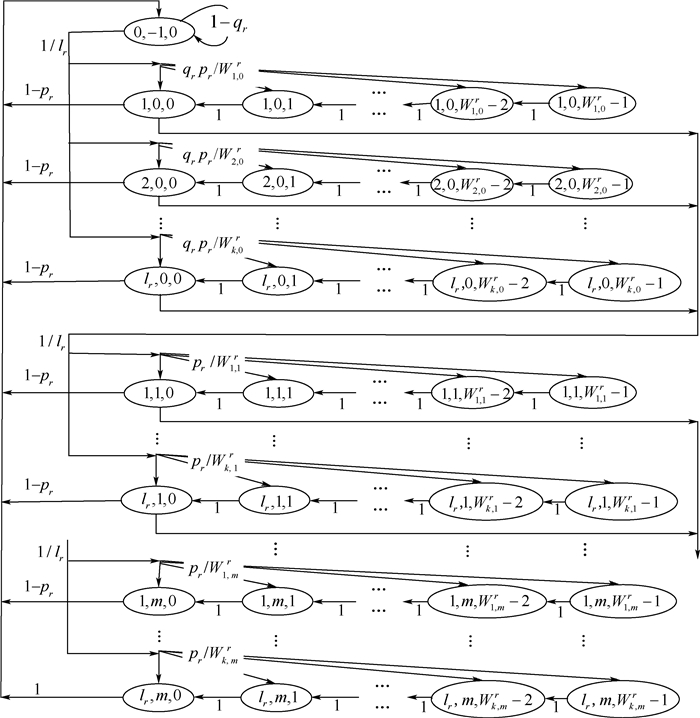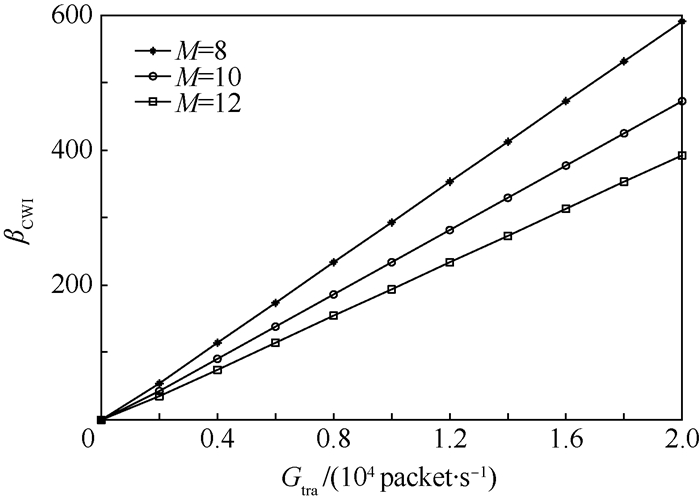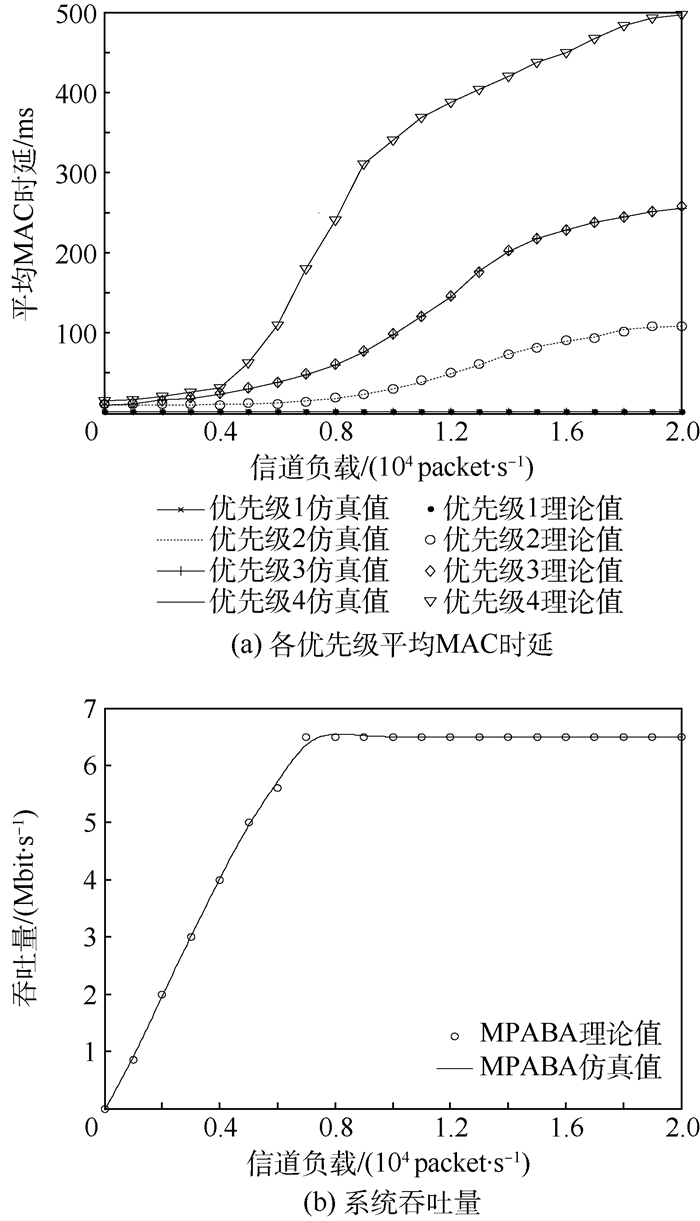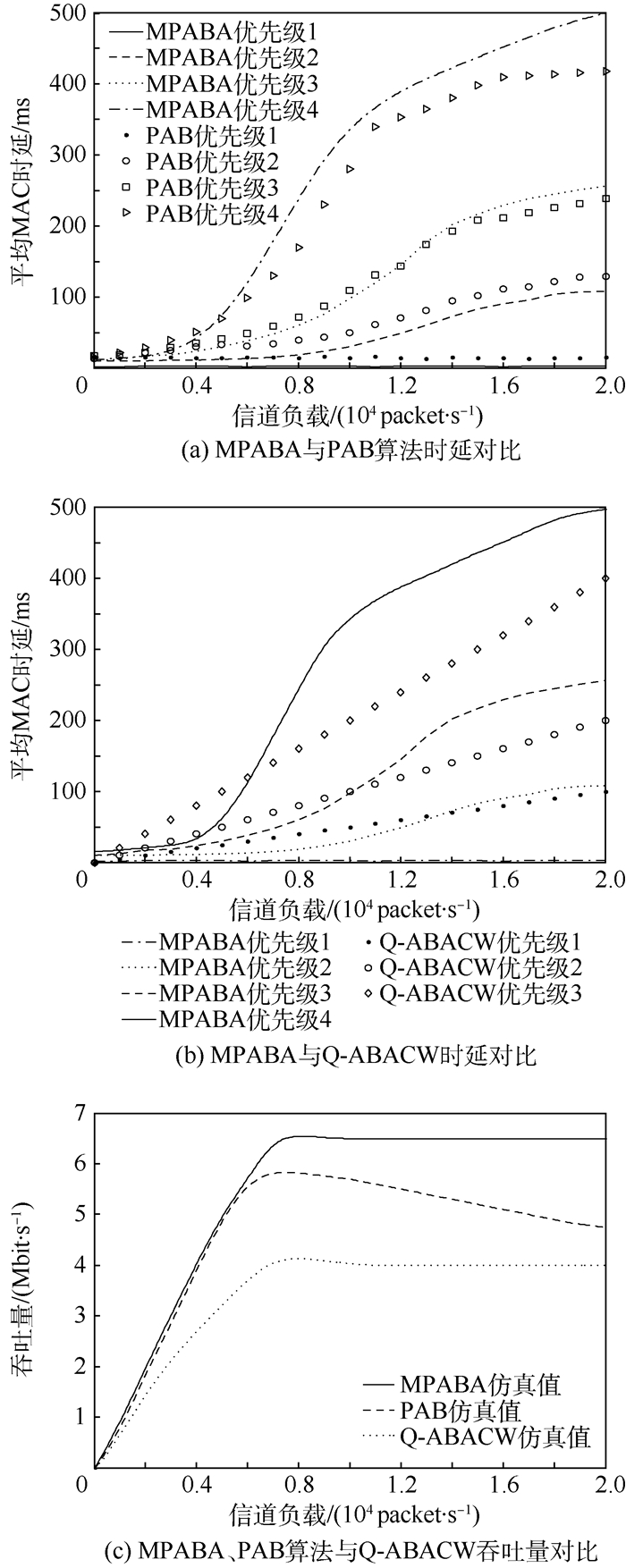-
摘要:
针对现有媒质接入控制(MAC)协议退避算法无法为蜂群无人机自组网(FANETs)提供区分服务,且在重负载时性能严重恶化等问题,提出一种多优先级自适应退避算法。采用忙闲因子自适应机制和最优竞争窗自适应机制,根据信道忙闲程度和网络状态参数自适应实时更新各优先级竞争窗口(CW)长度,从而使每次退避的竞争窗口可快速收敛到最佳状态,并实现了多业务区分服务,得到了最优的系统性能。通过建立不同优先级退避过程的三维Markov链模型求解得到了饱和吞吐量下的最优竞争窗自适应因子,并且理论推导了系统吞吐量和平均MAC时延的数学表达式。仿真结果表明,所提算法在重负载时能够实现多优先级区分服务并有效提高系统的吞吐量性能,相比区分业务优先级的自适应退避(PAB)算法和支持QoS的自适应竞争窗口退避算法(Q-ABACW),性能均有较大提升。
Abstract:The existing backoff algorithms of the medium access control (MAC) protocols cannot provide the multiple priority differentiation, and the performance declines sharply under heavy loads in flying Ad hoc networks (FANETs), so a novel adaptive backoff algorithm based on multiple priority differentiation is proposed in this paper. The algorithm adopts a busy/idle factor adaptive mechanism and an optimal contention window (CW) adaptive mechanism, so the length of CW for each priority can be adjusted in real time with the busy degree of channels and network state parameters. Meanwhile, the CW can quickly converge to the best state in every backoff stage, and the multiple priority differentiation can be obtained. Furthermore, the best system throughput performance can be achieved by modeling. The three-dimensional Markov chain model of the backoff process for different priorities is established and the adaptive factor under the saturated throughput is solved by theory. In addition, the mathematical expressions of system throughput and mean MAC delay are also deduced. Simulation results show that the algorithm can achieve the multiple priority differentiation and availably enhance the system throughput, and its performance is superior to the priority adaptive backoff (PAB) algorithm and adaptive CW backoff algorithm for QoS (Q-ABACW).
-
表 1 仿真参数设置
Table 1. Simulation parameter setting
参数 数值 节点数量 50 信道数量 10 信道传输速率/(Mbit·s-1) 3 分组长度/bit 1000 编码效率 1/3 单位时隙/μs 100 各优先级最大退避次数 10 分组拆分突发数 28 分组成功接收所需最低突发数 14 表 2 各业务类型相关参数
Table 2. Related parameters of each priority type
优先级 信息种类 lr Athr/(packet·s-1) 1 武器协同信息 2 态势感知信息 20 18750 3 网络管理信息 30 5745 4 天气、环境信息 40 1875 -
[1] 袁政英.美空军未来20年小型无人机发展路线图[J].防务视点, 2016(10):58-59.YUAN Z Y.United States air force in the next 20 years the development of a small UAV roadmap[J]. Defense Point, 2016(10):58-59(in Chinese). [2] 陈方舟, 黄靖皓, 赵阳辉.美军无人"蜂群"作战技术发展分析[J].装备学院学报, 2016, 27(2):34-37. doi: 10.3783/j.issn.2095-3828.2016.02.008CHEN F Z, HUANG J H, ZHAO Y H.Analysis on unmanned swarm fighting system of US armed forces[J]. Journal of Equipment Academy, 2016, 27(2):34-37(in Chinese). doi: 10.3783/j.issn.2095-3828.2016.02.008 [3] SHARMA V, KUMAR R, KUMAR N.DPTR:Distributed priority tree-based routing protocol for FANETs[J]. Computer Communications, 2018, 122:129-151. doi: 10.1016/j.comcom.2018.03.002 [4] KHAN M A, SAFI A, QURESSHI I M, et al.Flying ad-hoc networks (FANETs): A review of communication architectures, and routing protocols[C]//2017 First International Conference on Latest trends in Electrical Engineering and Computing Technologies (INTELLECT).Piscataway, NJ: IEEE Press, 2017: 1-9. [5] BEKMEZCI I, SAHINGOZ O K, TEMEL S.Flying ad hoc networks(FANETs):A survey[J]. Ad hoc Networks, 2013, 11(3):1254-1270. [6] OZGUR K S.Networking models in flying ad-hoc network evaluation:Challenges concepts and challenges[J]. Journal of Intelligent & Robotic Systems, 2014, 74(1-2):513-527. [7] ULLAH A, AHN J S.Performance evaluation of X-MAC/BEB protocol for wireless sensor networks[J]. Journal of Communications and Networks, 2016, 18(5):857-869. doi: 10.1109/JCN.2016.000114 [8] DIACONU F.A modified binary exponential backoff algorithm for improving the quality of service in highly populated IEEE 802.11e networks[C]//International Symposium on Signals, Circuits and Systems ISSCS2013.Piscataway, NJ: IEEE Press, 2013: 1-4. [9] FIRYAGUNA F, CARVALHO M M.Performance of polling disciplines for the receiver-initiated binary exponential backoff MAC protocol[J]. Ad Hoc Networks, 2015, 59(1):1-19. [10] QI H, HU Z Q, WEN X M.An enhanced MAC backoff algorithm for heavy user loaded WLANs[C]//2017 IEEE Wireless Communications and Networking Conference (WCNC).Piscataway, NJ: IEEE Press, 2017: 1-6. [11] IKRAM S, SEUNG-HUN S, BYEONG-HEE R, et al.Performance improvement of QoS-enabled WLANs using adaptive contention window backoff algorithm[J]. IEEE Systems Journal, 2018, 12(4):3260-3270. doi: 10.1109/JSYST.2017.2694859 [12] 卓琨, 张衡阳, 郑博, 等.一种优先级区分的机载无线网络MAC层自适应退避算法[J].航空学报, 2016, 37(4):1281-1291.ZHUO K, ZHANG H Y, ZHENG B, et al.An adaptive backoff algorithm in MAC layer for airborne network based on priority differentiation[J]. Acta Aeronautica et Astronautica Sinica, 2016, 37(4):1281-1291(in Chinese). [13] ZHANG B, HU Z, XING K.Performance of RS-Turbo concatenated code in AOS[C]//11th International Conference on Electronic Measurement & Instruments.Piscataway, NJ: IEEE Press, 2013: 983-987. [14] 刘炜伦, 张衡阳, 郑博.机载自组网信道占用统计预测机制[J].计算机工程与应用, 2018, 54(15):78-83. doi: 10.3778/j.issn.1002-8331.1801-0211LIU W L, ZHANG H Y, ZHENG B.Statistical prediction mechanism for channel occupancy in airborne ad hoc network[J]. Computer Engineering and Applications, 2018, 54(15):78-83(in Chinese). doi: 10.3778/j.issn.1002-8331.1801-0211 [15] XU D H, ZHANG H Y, ZHENG B, et al.A priority differentiated and multi-channel MAC protocol for airborne networks[C]//The 8th IEEE International Conference on Communication Software and Networks(ICCSN).Piscataway, NJ: IEEE Press, 2016: 64-70. -








 下载:
下载:






